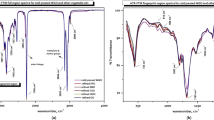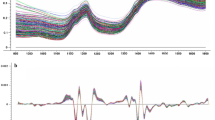Abstract
NIR reflectance spectroscopy was used to analyze the total oil and fatty acid concentration of Virginia and Valencia types of in-shell peanuts rapidly and nondestructively. NIR absorbance spectra were collected in the wavelength range from 400 to 2,500 nm using a NIR instrument. Average total oil concentrations of all samples were determined by a standard Soxtec extraction method. Fatty acids were converted to the corresponding methyl esters and measured using gas chromatography. Partial least squares analysis was performed on the calibration set, and models were developed for predicting total oil and fatty acids. The best model was selected based on coefficient of determination (R 2), standard error of prediction, and residual percent deviation (RPD) values. Virginia-type in-shell peanuts had RPD values of >5.0 for both absorbance and reflectance models, indicating that the method could be used for quality control and analysis. Valencia peanuts had an RPD value of 3.01, which indicates that the model is good for initial screening purposes. For both types of peanuts, fatty acid prediction gave RPD values of <5 for all the models, indicating they could be used for initial screening purposes.






Similar content being viewed by others
Notes
Company or trade names are mentioned for the purposes of description only, and this does not imply any endorsement by the USDA.
\( {\text{SEC}} = \left( {{\frac{1}{n - p - 1}}\sum\nolimits_{i = 1}^{n} {e_{i}^{2} } } \right)^{{\frac{1}{2}}}, \) where n is the number of observations, p is the number of variables in the regression equation, and e i is the difference between the observed and reference values for the ith observation.
\( {\text{SEP}} = \left( {{\frac{1}{n - 1}}\sum\nolimits_{i = 1}^{n} {(e_{i} - \bar{e})^{2} } } \right)^{{\frac{1}{2}}}, \) where n is the number of observations, e i is the difference between the predicted and measured moisture contents for the ith sample, and \( \bar{e} \) is the mean e i for all samples.
References
Kandala CVK, Nelson SO (1990) Measurement of moisture content in single kernels of peanuts: a nondestructive electrical method. Trans ASAE 33(2):567–572
Kandala CVK (2004) Moisture determination in single peanut pods by complex RF impedance measurement. IEEE Trans Instrum Meas 53(6):1493–1496
Cozzolino DM, Kwiatkowski J, Dambergs RG, Cynkar WU, Janik LJ, Skouroumounis G, Gishen G (2008) Analysis of elements in wine using near infrared spectroscopy and partial least squares regression. Talanta 74:711–716
Nimaiyar S, Paulsen MR, Nelson RL (2004) Rapid analysis of fatty acids in soybeans using FTNIR (ASABE Paper No. 046118). ASABE, St. Joseph, MI, USA, p 15
Pérez-Vich B, Velasco L, Fernández-Martínez JM (1998) Determination of seed oil concentration and fatty acid composition in sunflower through the analysis of intact seeds, husked seeds, meal and oil by near-infrared reflectance spectroscopy. JAOCS 75:547–555
Velasco L, Becker HC (1998) Estimating the fatty acid composition of the oil in intact seed rapeseed (Brassica napus L.) by near infrared reflectance spectroscopy. Euphytica 101:221–230
Daun JK, Clear KM, Williams P (1994) Comparison of three whole seed near infrared analyzers for measuring quality components of canola seed. J Am Oil Chem Soc 71:1063–1068
Bhatty RS (1991) Measurement of oil in whole flaxseed by near-infrared reflectance spectroscopy. J Am Oil Chem Soc 68:34–38
Tillman BL, Gorbet DW, Person G (2006) Predicting oleic and linoleic acid concentration of single peanut seeds using near-infrared reflectance spectroscopy. Crop Sci 46:2121–2126
Fox G, Cruickshank A (2005) Near infrared reflectance as a rapid and inexpensive surrogate measure for fatty acid composition and oil content of peanuts (Arachis hypogaea L.). J Infrared Spectrosc 13:287–291
Panforda JA, DeManb JM (1990) Determination of oil concentration of seeds by NIR: influence of fatty acid composition on wavelength selection. J Am Oil Chem Soc 67:473–482
Jaya S, Kandala CV, Holser RA, Windham WR, Kays SE, Butts CL, Lamb MC (2009) Nondestructive estimation of oil and moisture content using NIR spectroscopy in Valencia and Virginia peanuts. In: AOCS Annual Meeting, Orlando, FL, USA, 3–6 May 2009
Jaya S, Kandala CV, Holser RA, Windham WR, Butts CL (2009) Estimating oil and fatty acids contents of in-shell peanuts using NIR spectroscopy. In: ASABE Georgia and Florida Section, Daytona Beach, FL, USA, 11–13 June 2009
ASAE Standards (1982) Moisture measurements—peanuts (S410.1). ASABE, St. Joseph, MI, USA
Fearn T (2002) Assessing calibration; SEP, RPD, RER and R2. NIR News 13:12–14
Williams PC (2001) Implementation of near-infrared technology. In: Williams PC, Norris KH (eds) Near-infrared technology in the agricultural and food industries. American Association of Cereal Chemists, St. Paul
Osborne BG, Fearn T (1993) Applications of near-infrared spectroscopy in food analysis. In: Osborne BG, Fearn T, Hindle PH (eds) Near-infrared spectroscopy in food analysis, 2nd edn. Longman, New York
Sato T (2002) New estimation method for fatty acid composition in oil using near infrared spectroscopy. Biosci Biotechnol Biochem 66:2453–2458
Williams P, Norris K (2001) Near-infrared technology in the agricultural and food industries, 2nd edn. AACC, St. Paul
Pazdernik DL, Killam AS, Orf JH (1997) Analysis of amino and fatty acid composition in soybean seed, using near infrared reflectance spectroscopy. Agron J 89:679–685
Author information
Authors and Affiliations
Corresponding author
About this article
Cite this article
Sundaram, J., Kandala, C.V., Holser, R.A. et al. Determination of In-Shell Peanut Oil and Fatty Acid Composition Using Near-Infrared Reflectance Spectroscopy. J Am Oil Chem Soc 87, 1103–1114 (2010). https://doi.org/10.1007/s11746-010-1589-7
Received:
Revised:
Accepted:
Published:
Issue Date:
DOI: https://doi.org/10.1007/s11746-010-1589-7




